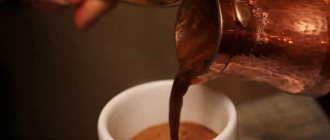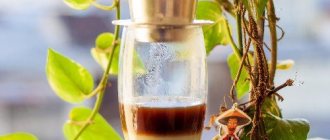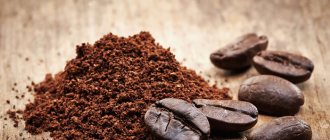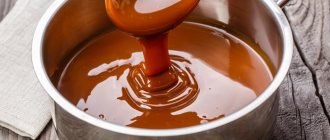Currently, the word “coffee” refers to a drink, most often hot, obtained by brewing crushed coffee beans. Literally translated from Arabic, the name coffee sounds like an stimulating drink..
Indeed, after drinking the drink, a strong stimulating and stimulating effect is felt, due to the caffeine content in it.
Today, the real magic of this drink with its enchanting aroma can be discovered by visiting Italy. After all, it was there that coffee turned into a part of the national cuisine, inseparable from pizza, pasta and olive oil. When you come to Italy, you can try at least one of the many varieties of coffee served in Italian bars. And having tried this rich, strong drink in its pure form or with the addition of milk foam, ice cream, liqueur or lemon, you will rediscover all the facets of its taste .
Origin
Probably no one will be able to say for sure when and by whom coffee was discovered. One version of the origin of coffee takes us back to 900 BC.
It was then, according to legend, that one of the Ethiopian shepherds noticed the very active behavior of goats after eating red berries on one of the trees. After tasting these berries, the shepherd felt his body filling with strength and energy.
It was in this area of Ethiopia, called Kaffa, that the coffee tree and coffee, the drink obtained from it, found their name.
Since then, they have tried to process the fruits of the coffee tree in a variety of ways. The grains were dried, boiled, crushed, and made into a tincture. And all this for the sake of the tonic effect of coffee beans. Over time, the Ethiopian lands were occupied by the Arabs, and the habit of consuming the tonic product took root among the new residents. They ground raw grains, mixed them with fat and made balls that were very convenient to take on the road. Raw coffee beans are small nuts that contain caffeine. Therefore, the resulting ground product could both feed and invigorate travelers during long journeys.
It wasn't until many centuries later that experiments with coffee beans came down to initial purification, followed by roasting and grinding to further brew the resulting powder.
The resulting aromatic drink could not compare to the initial attempts to consume coffee beans. Historians say that coffee seeds were first roasted in Yemen in the 11th century AD. In addition, the Arabs began to add cinnamon, ginger and other spices to the coffee drink when brewing.
By the mid-15th century, coffee reached Turkey. The easterners liked it so much that the church ministers had to curse the coffee with the name of the prophet. After all, they saw that believers began to spend much more time in coffee shops than in prayer. However, over time, the church's dislike of coffee faded.
Along with the widespread use of coffee, the art of preparing this drink also appeared. Places where coffee was prepared in public began to appear everywhere. Coffee shops became places for meetings, and coffee served as a reason for pleasant friendly communication. The image of coffee shops gradually moved to Europe over time. And their inner world is reflected in modern cafes.
Coffee came to us from Turkey. However, the bitter drink could not take root in Rus' in the Middle Ages. However, in the 18th century, Peter I began to insist on drinking coffee, believing that it promoted mental agility. And after 1812, drinking coffee in Russia began to be considered a sign of good manners.
How is coffee made in Italy?
Espresso is the most popular in Italy, since Italians prefer to drink coffee often, but in small portions. Espresso is most often called coffee, meaning a small, half-filled cup of an aromatic drink with a soft, noble taste. Italian espresso has a dense golden foam that covers the entire surface of the drink.
Coretto coffee, which is prepared on the basis of espresso with the addition of alcohol (liqueur, wine or vodka), is considered to be primordially Italian. Due to alcohol, the drink acquires a special piquancy and rich taste. Italians love coffee with milk: cappuccino, latte, macchiato and mochaccino. But these drinks are usually consumed only in the first half of the day. In the afternoon, coffee with milk in Italy can only be drunk by tourists who do not know local traditions.
For Italians, coffee is indispensable not only in the morning, but also during the day, since they need to cheer up and replenish energy before lunch. They also drink a tonic drink after eating to avoid drowsiness, as well as at the end of the working day. Many people don’t limit themselves to this and treat themselves to aromatic coffee after dinner. There are also some specific features of how coffee is drunk in Italy.
- For example, coffee is not served too hot so as not to burn yourself;
- As a rule, double espresso is not ordered in coffee shops. Italians prefer the classic volume of espresso. Americano in the Italian version is aqua sporca. It is espresso diluted with hot water to a volume of 120 ml.
- Coffee is often drunk while standing, since it is believed that this is how it is better absorbed;
- In coffee shops, you order a drink at the counter, loudly announcing your choice, even if the barista is not looking at you. As soon as the cup is drunk, they pay.
The traditions of coffee drinking are so strong and rich that they are deeply rooted in Italian culture. Its special flavor and originality prompted the creators of Nespresso coffee to create new capsules TRIBUTE TO MILANO and TRIBUTE TO PALERMO. The limited edition Tribute to Milano blend is inspired by the fast-paced life of Milan, where even coffee is drunk quickly. The aromatic blend Tribute to Palermo captivates with the fragrance of spices and the slightly bitter taste of Sicilian cocoa. He became the embodiment of the measured life of Palermo.
Both blends are based on the best varieties of Arabica and Robusta. Like real Italian coffee, they are suitable for strong ristretto and espresso, as well as various drinks with added milk. Based on Tribute to Milano, you can prepare an excellent Latte Macchiato, which has a mild taste and caramel aroma. Tribute to Palermo is perfect for aromatic cappuccino with a pleasant chocolate tint.
History of espresso
Recently, going to a cafe and drinking coffee has become fashionable, and such a way of life has appeared. Invite friends not to your home, but to a cafe for a cup of coffee. When ordering a classic espresso, we don’t even think that this brewing method was invented in Italy, and then widely spread throughout the world. And today, residents of America and Europe, as well as the Middle East and Asia, prefer this type of coffee.
The first espresso machine was introduced in Italy in 1905. The principle of its operation was based on passing water, condensed from steam, under pressure through ground coffee. The taste of the resulting coffee was radically different from the modern drink. Due to severe overheating, the coffee acquired a burnt taste. The main consumers of this coffee were the bourgeoisie, and a little later the preparation method spread to Germany and France.
The mid-20th century saw a major change in the approach to coffee making. Steam has been removed from the espresso machine. Instead, the water was heated to no more than 92 degrees and forced under high pressure through the coffee. It was then that the taste of espresso that we know today appeared. Gradually, the machines were improved, and now espresso is made very quickly and with precise temperature control.
How to drink coffee the Italian way
✅Italians do not drink coffee in “cans,” that is, from large mugs, in the American manner. For breakfast and after a heavy lunch or dinner, they usually drink espresso from microscopic coffee cups. In the morning, before 11-12 o’clock, more variations are allowed: it could be cappuccino or latte macchiato, but most often it’s espresso.
✅Espresso, according to Italians, greatly helps digest food , so they drink it after eating. No cappuccino or other variations of coffee with milk - heaviness in the stomach and indigestion are guaranteed (again, according to some Italians).
✅ Due to the fact that espresso is served in special thick-walled cups, and the volume of the drink itself is small, Italians very rarely drink coffee on the go , as, for example, Americans or residents of megacities like Moscow like it. Italians prefer to drink coffee either at the bar, or in a relaxed state after a delicious lunch.
✅Some regions of Italy prefer their own varieties of coffee-based drinks; be sure to try them along with local specialties. For example, in Sicily they really love coffee granita (crushed ice with espresso and whipped cream on top). In Naples, you should order un caffè alla nocciola - espresso with nut foam, and in Piedmont - un marocchino, an espresso-based drink with frothed milk and added cocoa.
Types of coffee trees
There are about 200 varieties of coffee trees in the world. Of these, only 20% is used by humans. And only 2 main ones are of interest to coffee connoisseurs. Arabica coffee (Coffea Arabica), called Arabian, and Robusta coffee (Coffea Canephora), called Congolese. 90% of coffee consumed comes from the fruits of these particular tree species.
Arabica
The Arabian coffee tree is considered the most popular type of coffee tree. 70% of the world's coffee is produced from its fruits.
The natural height of this tree reaches 6-8 meters, but for ease of harvesting, it is not allowed to grow more than 4 meters.
Arabica fruits are red in color and turn purple when ripe. The length of the fruit can reach 15 mm. The plant is very capricious to climatic conditions and sensitive to diseases and pests. Over the course of a year, one tree produces about 5 kg of fruit, which produces up to 1 kg of finished coffee beans.
Arabica fruits contain 18% aromatic oils and about 1.5% caffeine. The taste of Arabica in the finished drink is sweetish with a slight sourness. The best varieties of Arabica are Bourbon, Maragogipe and Typica.
Robusta
The height of the Canephora or simply Robusta coffee tree in nature can reach 10 meters. But during mass cultivation, it is pruned and shaped into small trees. Robusta flowers are pale pink, and the fruits are greenish or brownish-grayish.
This tree was first discovered in the Congo River Basin in Africa. Today, Robusta trees are grown in both Africa and Asia, mainly on lowland plantations. The plant is quite unpretentious in care. It tolerates temperature changes well and is resistant to diseases and pests. Up to 15 harvests can be harvested from a Robusta coffee plantation per year. It is precisely because of its unpretentiousness and high yield that it is very profitable to grow Robusta.
Robusta fruits contain 8% aromatic oils and up to 3.5% caffeine. The taste of this type of coffee is very specific and quite strong. Because of this, it is most often used to add strength to coffee blends. The taste of Robusta also improves during the production of instant coffee. Despite its lower taste compared to Arabica, Robusta makes up 30% of all coffee produced.
Arabica and Robusta, in turn, are divided into many varieties depending on the region of origin. All varieties differ from each other in both taste and aromatic properties.
In addition to varieties, there is also a coffee classification based on the quality of the beans obtained. For example, SHG is coffee from mountainous areas, HG is coffee from foothills, MG or CS is coffee from lowland plantations; HB – hard bean coffee; A – best quality coffee, B – average quality coffee, C – low quality coffee, AA – best, AB – good, BA – average, BB – low quality.
Culture of preparation and consumption
In Italy they love coffee so much and drink it so much that they have come up with many ways to prepare it. Italians make coffee for breakfast, together with or instead of smoke breaks and, of course, after meals along with dessert.
The classic type of coffee, also called “normale” (from “normale” - ordinary), is considered espresso. What is served in Russia and the countries of the former Soviet Union as espresso is most often very different from its Italian counterpart.
Italian espresso is a velvety dense foam with a golden tint that covers the entire surface of the coffee in the cup, a soft aroma that fills the entire room and makes you forget about everything. The perfect, balanced, pronounced taste of real Italian espresso cannot be described in words.
According to the rules of coffee etiquette, espresso is served in a porcelain cup with thick walls shaped like a truncated ellipse. The standard volume of such a cup is 75 ml, but the contents, depending on the type of coffee, should take from 25 to 50 ml. This serving maximizes the taste and aroma of coffee. In bars, coffee is brewed by a special specialist called a barista.
A minute of Italian: how to order coffee at a bar
Want to order coffee at an Italian bar but don't speak the local language? No problem! You only need to say a couple of simple phrases:
- To order coffee (in this case, espresso), simply say: “Un caffè, per favore”;
- If you want to order more than one drink at a time, replace UN with due (two), tre (three), quattro (four), etc.;
- If you want to order coffee with lactose-free / soy milk, just say the following: “(Name of the desired coffee drink) + con (con / “with”) + latte di soia (latte di soya / “with soy milk”) / con latte senza lattosio (con latte senza lattosio / “with lactose-free milk”);
- To ask for the bill, say "Posso pagare?" (posso pagare / “Can I pay?”), or: “Il conto, per favore” (il conto, per favore / “Bill, please”) - and then list at the checkout everything you ordered;
By the way! In some bars, it is customary to first pay at the cash register and then take your order: in this case, dictate everything you want to take, pay, and then go to the bar with the receipt;
- At the end say: “Grazie” (grace, that is, “Thank you”), and then add: “Buona giornata!” (buòna djornàta / “Have a nice day!”). Politeness is pleasant for everyone, and in Italy it is an integral part of the local mentality!
You can learn even more interesting information about coffee from a professional barista on a special excursion for coffee lovers .
Kinds
The most popular type of coffee is, of course, espresso
.
Its smaller version, ristretto
, is a standard portion of ground coffee, but in the amount of 1 sip, i.e. 20 ml. This coffee contains more aroma and less caffeine compared to its classic counterpart.
Watch a video about 10 types of coffee drinks popular in Italy:
Lungo
Lungo
- This is espresso diluted with hot water to double the volume. This coffee contains more caffeine due to the longer passage of water through the ground coffee.
Cappuccino
Cappuccino is espresso with a large amount of milk foam reaching the edge of the cup.
The airy foam is sprinkled with cocoa powder or grated chocolate on top. Professional baristas use milk and chocolate to create a design on its surface. In Italy it is customary to drink coffee with milk before lunch time, i.e. until 11 o'clock. For example, a typical first breakfast is a cup of aromatic cappuccino, a croissant and freshly squeezed orange juice. Cappuccino is served in a preheated porcelain cup.
Americano
Americano
– This is a full teapot of coffee (up to 470 ml), prepared with one serving of ground coffee. The Italians call this coffee aqua sporca, which means dirty water. The truly American brewing method uses a filter coffee maker. In Europe, Americano brewing has undergone changes, and classic espresso is simply diluted with hot water to a volume of 120 ml.
Latte
Latte
– one of the options for coffee with milk. Practically, it is milk with the addition of milk foam, diluted with a small amount of coffee. Moreover, the coffee is poured into the heated milk in a very thin stream, and not vice versa. Served in a tall transparent glass of 200 ml.
Mocha or Mochaccino
Mocha or Mochaccino
This is a type of latte coffee. In this case, one-third of the drink is espresso, and the remaining two-thirds is hot chocolate, milk and whipped cream. Delicious.
Macchiato
Macchiato
– espresso with a little milk added. It is also called marbled or stained coffee.
Coretto
Coretto
– coffee for those for whom the coffee strength is not enough, and then a portion of alcohol is added to the espresso. It could be whiskey, grappa or liqueur. Moreover, depending on the type of alcoholic drink, you can determine the possible origin of the recipe.
- So, coffee with whiskey is Irish coffee;
- with vodka - Russian coffee;
- with gin - English coffee;
- with schnapps - German .
Coffee with the addition of amaretto is considered classic Italian.
Glasse
Glasse
is a shot of espresso topped with ice cream. The coffee is cooled to approximately 10 degrees Celsius before adding ice cream. Ice cream makes up a quarter of the total. Chocolate, cinnamon and caramel can be used as an addition.
Romano
Romano
– espresso with a little lemon juice added.
Types of Italian coffee and coffee drinks
Flat white, latte with sweet syrups, coffee in avocado or with activated carbon... Forget about all these types of coffee drinks inspired by modern fashion, because real Italian coffee is served only in several variations of different strengths:
1.
Caffè (caffe') is what we are all used to calling “espresso”, namely, invigorating coffee with a rich taste.
Served in tiny cups; 2. Caffè ristretto (caffè ristretto, or caffè corto) - literally translated as “shortened coffee”: this is “espresso” that is prepared with less water, due to which the taste becomes even more intense. Served with a glass of water at the end;
3. Caffè doppio (caffè doppio) – double portion of caffè;
4. Caffè lungo – translated as “long coffee”: this is an espresso that is prepared with a double portion of water. Therefore, the taste is a little softer;
5. Caffè decaffeinato (caffe' decaffeinato) - espresso without caffeine;
6. Сaff è con panna (caffe' con panna) – espresso with a “cap” of sweet whipped cream on top;
7. Caff è macchiato (caffe' macchiato) - literally - “dirty coffee”, but in reality - espresso, to which a drop of milk is added for a more delicate taste;
8. Latte macchiato (latte macchiato) is what in Russia is usually called simply “latte” ( with emphasis on the first syllable ). Only in Italian “latte” means “milk”. So if you pop into your local bar and order a latte, don’t be surprised when they serve you a glass of regular milk. But latte macchiato is a drink made with steamed hot milk, to which a small shot of espresso is added;
Only in Italian “latte” means “milk”. So if you pop into your local bar and order a latte, don’t be surprised when they serve you a glass of regular milk. But latte macchiato is a drink made with steamed hot milk, to which a small shot of espresso is added;
9. Cappuccino (cappuccino) is everyone’s favorite coffee drink, which is prepared on the basis of espresso, milk and milk foam. In Italy, cappuccino, like all coffee drinks with added milk, is usually drunk for breakfast;
10. Caff è latte (caffe' latte) is just coffee with milk. Here the amount of coffee and hot milk is in proportions of 1:1.
What about the popular Americano? You will learn about this a little later!
What is the best coffee
Despite the very popular myth all over the world that the best coffee is produced in Italy, we have to disappoint you. Coffee is not produced in Italy. Due to climatic conditions, coffee trees are not grown in this country.
Italians simply love this stimulating drink. For them, coffee is a basic necessity. That is why the best coffee blends are produced in Italy, which have won the love of both amateurs and avid coffee lovers all over the world.
There are many coffee roasting companies open in the country. Almost all of them produce good quality beans suitable for further use in both espresso machines and home coffee machines. Italians believe that coffee, in addition to good quality, should also be affordable. Therefore, coffee, including for export, is prepared so that the espresso obtained from it is of above average quality.
Each region of Italy has its own favorite supplier of coffee beans . Next to bar signs there is usually a logo with the type of coffee served in this establishment. Large retail chains are also trying to sell roasted coffee beans under their own brand.
The best brands of Italian coffee are deservedly considered Lavazza, Illy, Cartapani and Trombetta. The Illy brand is owned by the Illy family from Triete, and Lavazza was founded in 1895 as a small family business by Luigi Lavazza. In the 18th century, no one could have imagined that a family business two hundred years later would become a sales leader in dozens of countries around the world. Today, the offices of this company are located in the capitals of many countries around the world.
Despite such resounding success and widespread popularity, the Lavazza family continues to carefully preserve the recipes and knowledge bequeathed to them by their great-grandfather, the founder. The company controls the processes of creating coffee, from picking the fruit to roasting and grinding.
How to drink coffee the Italian way
There are several unwritten rules regarding coffee consumption that Italians try to adhere to in everyday life:
- Drink coffee drinks with added milk only before noon. Many people have heard about this “rule,” but not everyone knows what exactly it involves. In fact, reducing milk consumption in the afternoon is explained by the fact that in the evening hours it is poorly absorbed by the body and slows down metabolism. But a cup of strong coffee, on the contrary, helps stimulate it, so in Italy it is customary to drink espresso (caffè) after a meal in order to digest what you have eaten;
- In Italy, there is no fashion for prolonged drinking of coffee drinks, to which we are so accustomed. Here it looks more like: dropped into a bar, drank coffee, exchanged a few words with the barista and left;
- Drink coffee at the bar. This is done in order not to overpay for table service, which is automatically included in the bill if you decide to sit down and slowly drink coffee (+ 1-3 euros);
- While you are in Italy, forget about the popular “coffee-Americano”: according to the Italians, it is just (we quote): “...poor and unfortunate caffè espresso, impossibly diluted with water to the state of... an incomprehensible slurry”!
- And one more thing: drinking cappuccino and any other coffee drinks during lunch or dinner (at the same time as the main courses) is considered truly wild, see the rules of conduct in an Italian restaurant

Dessert for coffee
Tiramisu is considered a traditional Italian dessert for coffee. And although today this delicious dessert is prepared all over the world, it was born in Italy. The associations that arise in your head when you hear the word tiramisu are soft cheese, airy cookies, dark chocolate and, of course, coffee...real, hot, thick, aromatic with a slight bitterness.
Soft Italian mascarpone cheese is used to prepare this culinary miracle. In appearance it looks like very thick cream, but in taste it resembles not at all sour cottage cheese. The second integral element of tiramisu is savoiardi biscuits, glazed with sugar crumbs.
Biscuit fingers are soaked in a mixture of strong black coffee and alcohol. The alcohol can be cognac, brandy or liqueur, such as coffee. The soaked cookies are layered with delicious cheese and sprinkled with grated dark chocolate on top. If the cake is to be served on a children's table, then strong drinks should be excluded from the recipe.
The only drawback of this wonderful dessert is its high calorie content. Therefore, those who are prone to excess weight should probably not get carried away with such tempting tiramisu. But you just need to try a small piece.
3. Types of coffee in Italy
✅Espresso is the basis of Italian coffee drinking. Not a single day is complete for an Italian without a cup of espresso, this extremely popular coffee drink in Italy. The word espresso has two meanings: “fast” and “pressed”. This drink, brewed in a coffee maker or coffee machine by passing a small amount of water under pressure through a filter containing ground coffee, is served in special thick-walled cups called demitasse . The main feature of espresso, which all coffee lovers love so much, is the dense foam on top, called crema . Sometimes a small glass of water is served with espresso, but Italians often do without it entirely.
✅ Italians rarely order double espresso (caffè doppio), preferring, if they need another dose of caffeine, to simply approach the barista and place an order. Typically, double espresso is ordered by foreigners who find the standard portion too tiny.
✅Americano (caffè americano) originated during World War II, when the American military in Italy diluted espresso with hot water to bring its taste closer to the taste of filter coffee to which they were accustomed. The volume of coffee becomes larger, while the creamy crema characteristic of espresso remains.
✅Lungo (caffè lungo) literally means “long coffee,” that is, coffee with more water than is used to make espresso. The difference with an Americano is that lungo is prepared using an espresso machine, that is, the water is brewed along with the coffee, and does not dilute the already prepared coffee drink.
✅ Cappuccino is a faithful friend of a tourist. This is an espresso-based drink with the addition of hot frothed milk. Where did cappuccino get its name? Find out this, as well as where the oldest cafe in Rome is located and other secrets of the Italian dolce vita on our quest tour “Mysterious Rome” .
✅ Espresso macchiato (caffè macchiato) literally means “stained coffee” (macchia - stain). This is an espresso-based drink with a small amount of frothed milk, which looks like a white spot against the coffee foam.
✅ Coffee latte (caffè latte) is a coffee drink made from a serving of espresso and a cup of heated milk. Note that if you try to order a latte, like at Starbucks, in non-tourist places, they may bring you a glass of milk, so it’s worth adding the word “coffee” (in Italian it sounds like un cafe).
✅ Latte macchiato is the opposite of espresso macchiato, when espresso is poured into a large amount of milk in a 3:1 ratio, and a small coffee stain remains on the surface of the milk.
✅ Ice coffee (caffè freddo) is best ordered in the summer when it’s hot. It invigorates and refreshes.
How to make coffee correctly?
Coffee lovers should remember that high-quality coffee beans, proper roasting and optimal grinding are only half the way to a magical, aromatic drink. You also need to know how to make coffee properly. A serving of classic coffee is almost 99% water. Accordingly, the quality of this component affects the quality of the drink no less than the coffee beans themselves. Coffee tastes best when using cold, non-hard, fresh, oxygenated water. Practice has shown that if you prepare two servings of coffee with boiled warm water and fresh cold water, the difference will be obvious even to a non-taster.
Homemade coffee recipe from Italy4.me
There are incredibly many ways to make coffee at home, some cook in a Turk, some have equipped their kitchen with an espresso machine, others use the good old geyser coffee maker. By the way, the geyser coffee maker (or as it is also called a cafetiere) is based on the principle of the first espresso machine, which we mentioned at the beginning of the article.
WATCH THE VIDEO LESSON
So, let's move on to the recipe.
We will cook in Turk. First, add freshly ground coffee at the rate of 1 spoon per serving. Lovers of strong coffee can add a little more, but I don’t recommend going over the line of two spoons per serving, it produces too much caffeine, and the taste completely changes. If you prefer coffee with sugar, we recommend adding it immediately at the beginning of preparation, and not after the drink has already been served. I don’t know what the secret is, but the difference is noticeable. Finally, fill everything with water and put it on medium heat. A soft golden foam will begin to form on the surface. When it starts to rise, remove the Turk from the heat. Do not bring the drink to a boil under any circumstances!
It is best to serve it to the Turkish table, and let everyone pour their own coffee. This way it won’t have time to cool down, because you can’t heat up brewed coffee.
In conclusion, I would like to say that the taste of real coffee is influenced by many factors, ranging from the weather in which the fruits of the coffee tree ripened, storage conditions, degree of roasting and grinding to the art of brewing the drink. To feel the fullness of the taste and aroma of truly Italian coffee, go to the southern part of Europe, to a country washed by the waters of the Mediterranean Sea and warmed by the gentle southern sun.
Does coffee grow in Italy?
There is an opinion that the best varieties of coffee are grown in Italy. But this is not the case, since the local climatic conditions do not allow the cultivation of coffee trees. But the Italians, as true coffee lovers, produce magnificent blends that bring world fame to the country. There are a large number of companies specializing in coffee roasting in Italy.
Moreover, each region is dominated by its own manufacturer. Along with bar signs, you can usually see a logo with the type of coffee that is offered to visitors to the establishment. In large retail chains, coffee is also usually sold under its own brand. Today, the phrase “Italian coffee” is increasingly heard due to the popularity of cooking recipes borrowed from the Italians. They drink the invigorating drink so often that they have invented many interesting ways to prepare it.
Our store has excellent Italian analogues of Nespresso capsules. Try a wide variety of flavors!
E-books about coffee
Here is a list of interesting books about coffee that can be downloaded online:
- Coffee maker - interesting recipes for making coffee in various types of coffee makers.
- Coffee. 100 rules, stories, recipes - a collection of stories, rules, recipes and other knowledge about coffee.
- I love coffee! - an illustrated book about the most amazing drink in the Universe.
- It's Not About the Coffee - an abridged version of a book about Starbucks corporate culture. Only the most important things: ideas, techniques, key quotes.
- Fika, or Swedish happiness in a cup of coffee - from this book you will learn more about the Swedish lifestyle, their mentality, the “recipe” for happiness and inner comfort.
USEFUL SITES AND ARTICLES
️











